
SUBSCRIBE TO OUR NEWSLETTER
Subscribe to our newsletter to stay informed about articles, events, and updates from Wellness Impact.

Subscribe to our newsletter to stay informed about articles, events, and updates from Wellness Impact.
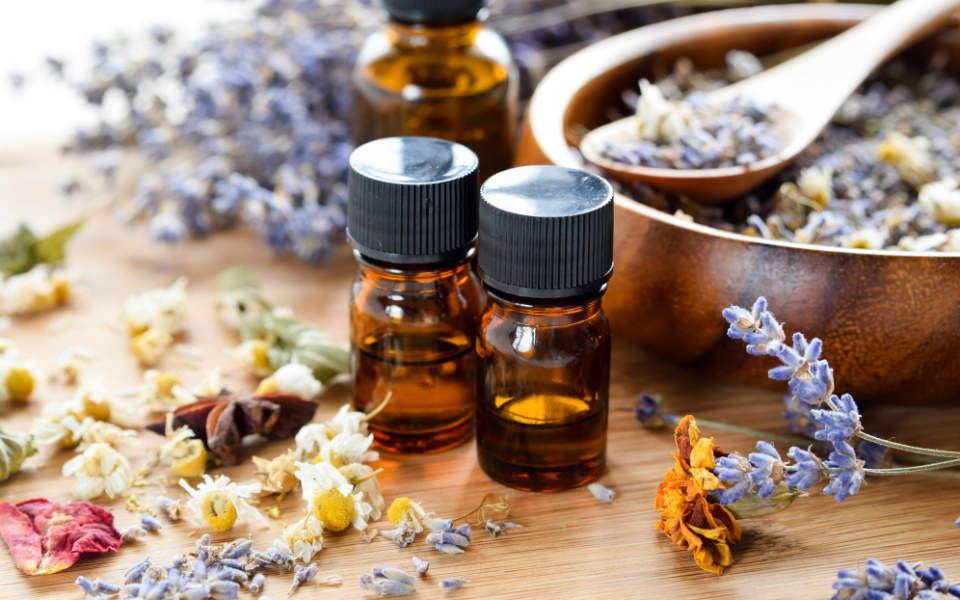
Essential oils are the essential “tools” in the aromatherapist’s toolbox. Unlike allopathic remedies that often translate to swallowing pills and potions, essential oils allow the patient to use smell as an extra aid in the healing process.
Essential oils are used in various holistic and complementary therapies, from massage therapy to aromatherapy to Ayurvedic therapies, to plain old first aid remedies, that can be applied at home.
Essential oils assist with both medical and psychological conditions. But they are often used for pleasure, to “sanitize the air” with their fragrant, subtle aromas. And, in doing so, uplift anxious emotions and calm worried minds.
Essential oils are often used in the cosmetic industry for hair, skin, and facial treatments.
Essential oils are volatile plant compounds extracted from aromatic herbs, shrubs, and trees. An extracted oil captures the “essence” of that specific plant. This makes each essential oil unique in both its composition and its therapeutic value.
The essential oils are part of a plant’s natural chemistry and these compounds,
Are what give the essential oils their therapeutic properties.
These compounds are stored in different concentrations throughout the plant. Different techniques, to extract the oils, are employed depending on where the highest concentrations of aromatic compounds are stored. Oils get extracted from the leaves, stems, flowers, seeds, bark, and even roots.
For example:
As the word implies, it is therapy through smell. Aromatherapy combines essential oils with massage therapy, but not exclusively. A qualified aromatherapist is just as likely to recommend bathing with essential oils, inhaling essential oils, and even using essential oils in compresses, for muscular injuries and pains.
It is the job of the aromatherapist to ascertain what type of oils are suited to each individual. Aromatherapy is not a one-size-fits-all application. The personal input (touch through massage) as well as the intuitive knowledge, that comes with experience, guides the aromatherapist in deciding what essential oil blends are needed for each individual case.
Aromatherapy is holistic in its approach. This means it assists the body by strengthening the body’s own ability to heal itself. In other words, certain essential oils have properties that boost our immune systems.

Essential oils are used to treat physical ailments like:
It is important to understand the brain/immune/olfactory system connection. They work together to receive and send signals and to active biological processes. When any of the body’s systems are impaired there will be a knock-on effect. And over time the body starts to show symptoms, left untreated symptoms become ailments, and ailments lead to disease.
When we see the logic in this it becomes clear why essential oils work and therefore benefit us.
Anxiety is a nervous condition that affects the mind and the body. Caused by stress, and left untreated, anxiety causes symptoms like increased heart rate and breathing. This stimulates the “fight or flight” response which activates stress hormones. Stress hormones activate adrenaline and cortisol, upsetting hormonal balances which cause the body’s gut health to deteriorate.
This impacts the entire body. So besides the mental disorder, digestion is impaired. This then affects the immune system and the body becomes susceptible to fungal, viral, and bacterial infection.
Anxiety interferes with:
Essential oils that aid and assist anxiety and other stress-related mood disorders include:
When it comes to skin care, essential oils are beneficial both cosmetically and medicinally.
Skin care involves treating conditions like oily, dry, and combination skin. It focuses on anti-ageing remedies, skin rejuvenation, toning, and conditioning.
Skin care also covers skin disorders like acne, eczema, psoriasis, and pigmentation problems.
Often first aid is needed to treat the skin for cuts, burns, bites, stings, and other wounds. There is an essential oil for almost every skin complaint.
Essential oils are added to beauty products so that they can be applied topically. Beeswax, aqueous cream, floral water, and base oils are all suitable vehicles for getting the oils absorbed by the skin and smelled by the nose and inhaled by the lungs.
It is common practice to use essential oils during facial saunas and as compresses. They are applied directly, diluted or neat, (in the case of lavender and tea tree oil).
The skin also happens to be an important delivery system for the application of essential oils treating issues not related to the skin. Because massage therapy is such an integral part of aromatherapy, and the oils are absorbed through the skin, nose, and lungs during treatment, it is considered a holistic therapy.
Essential oils that are beneficial to the skin include:
Lavender treats cellulite, eczema, acne, psoriasis, scabies, athletes foot, and thrush.
Use lavender essential oil on all skin types. Dry, oily, normal, combination, dehydrated, sensitive, and puffy skin can all be treated with lavender essential oil.
Good base oils for skin treatments include apricot kernel oil, grapeseed oil, and coconut oil for dry skin.
Hair problems include dry hair, damaged hair, oily hair, thinning hair.
But hair also needs to be maintained so treating certain hair types with certain essential oils, as part of a regular hair care regime is beneficial. Gentle on your hair and the environment.
If you are not familiar with hair oil treatments you may be put off at first. Many hair treatments involve massaging a blend of essential and carrier oils into the scalp. And then combing through the hair. Sometimes it is advised to sleep with these treatments overnight or walk around wearing a plastic cap for the day. Once the oils have penetrated the hair follicles you can shampoo and rinse.
When treating hair Argan oil is one of the best carrier oils to use. Other good base oils for hair include coconut, Amla oil, or jojoba oil. Jojoba oil can be heated and diluted with another oil as it is quite costly.
Essential oils for hair care include:
During winter months the lack of Sunshine D, and compromised immune systems, leave us susceptible to all types of chest complaints and breathing difficulties.
Conditions like laryngitis, colds, flu, bronchitis, pneumonia, general overproduction of mucous in the lungs from bad gut health, coughs and sneezing, all lead to various degrees of inflammation. Added to this are bacteria, fungal, and viral organisms floating around and lining surfaces. Our body responds by trying to throw off these “germs” and in doing so it produces the symptoms we call colds and flu. And generally the respiratory system is affected.
So any essential oils that have expectorant, anti-inflammatory, antiviral, antibacterial, antiseptic, disinfectant, antimicrobial, and antifungal properties are going to be beneficial in treating symptoms related to the respiratory system.
Essential oils with these properties include:
Sleep disorders are generally a result of other stressful conditions. And so it makes sense that the essential oils with the most benefits for sleep-related problems would be those with these properties:
The essential oils with properties that aid sleep, and also ease anxiety, include –
The fragrance of essential oils stimulate our olfactory system and send signals to our brain. This is a very simple way of explaining how essential oils work. A review of how essential oils support the immune system explains how it is possible for essential oils to promote healing in such a profound way.
The immune system can only perform optimally if the rest of the body is healthy and a healthy diet adhered to. By supporting the immune system the body is able to fight off infections and expel toxins more effectively.
Essential oils that support immune function include:
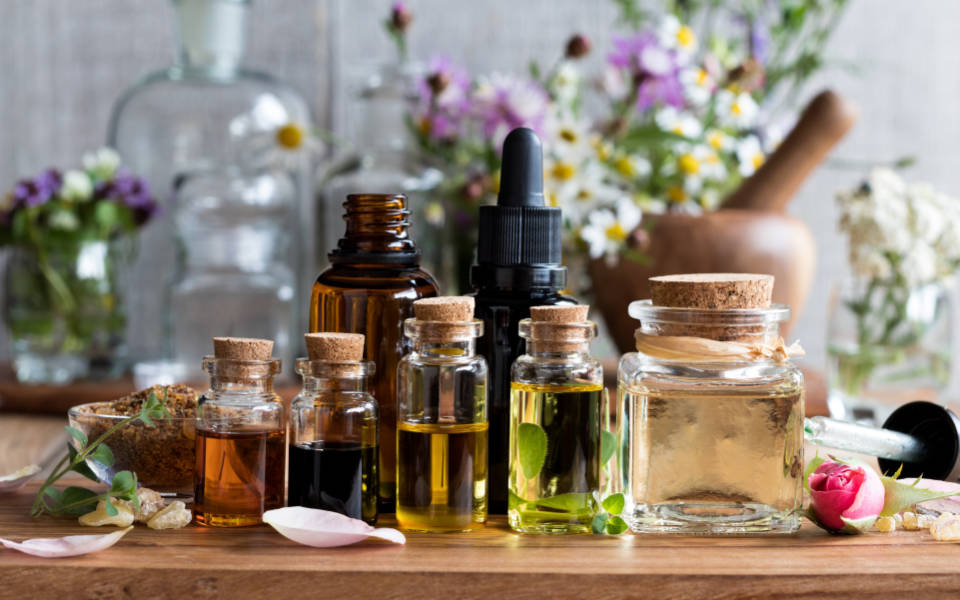
Essential oils work on both physical and psychological levels. Essential oils provide olfactory stimulation. When we smell, our olfactory senses send information to various parts of the brain. And this scent awakens biological processes throughout the body.
Essential oils are bioactive and synergistic. This means that they work because of the way their compounds interact and influence each other. The main attraction, for us humans, is the scent. Although the oils often get delivered via the skin, it is their smell that stimulates the brain to take notice of their arrival.
The compounds locked within the oil remain volatile. When the oils are diffused through various methods, the molecules, containing the active compounds, evaporate (get vaporised/ are diffused) and the therapeutic properties become accessible to us. See the section – Benefits of essential oils.
When essential oils are inhaled the absorption occurs via the lungs. Because the alveoli are so thin. So the three main delivery systems are through smell using the nose and the mind, through breathing via the lungs, and through absorption via the skin.
There are 5 methods of extracting essential oils from plants.
1. Distillation
This is the most widely used method. It is also the most effective way of getting a high level of purity. (It must be said, the condition of the actual plants used contributes greatly to the quality of the end product).
The plant matter is placed in a still, which is heated with water and steam. The high temperature causes the cells, containing the oils, to burst. The contents of the cells are caught up in the vapour and channelled into a condenser. The vapour cools and becomes liquid. The liquid is a mix of the essential oils and water. This gets separated and you’re left with a pure essential oil and a floral/herbal water.
Note: This method is not suited for extracting oils from Rose, Neroli, Jasmine, and other exotic flowers. The high heat destroys the scent. Enfleurage or solvent extraction would be the preferred methods here.
Used to extract the oils of intensely fragrant flowers. Instead of water, a solvent is used. Heat is applied, the solvent draws the compounds from the plants, and the resultant mix is filtered. This filtered product is called a “concrete”. Solvent is added. The concrete is chilled and filtered. This allows the remaining alcohol to evaporate. The remaining oil is potently fragrant and is now called an ‘absolute’.
Note: This process has advanced and alcohol/benzine is not used anymore. Hexane and ethanol are preferred solvents.
This process yields an essential oil that is of a higher quality than that attained through steam distillation and traditional solvent extraction. The CO2 is pressurized to become “supercritical”. This allows it to act as a solvent, without the residues left by hexane or ethanol. Because high heat is not applied the plant retains more of its original, unadulterated compounds.
This method is also called cold-pressing. It is the same method used to extract oils from olives. Only citrus fruits undergo this process. The oils of citrus are found in the peels.
It is the petals that get used during this highly specialized extraction process. Glass frames, lined with fat, are used. Fresh petals are spread over the fat. The petals are refreshed daily until the fat is saturated. This end product is called a ‘pommade’. It is “washed” in alcohol, which then evaporates, leaving a luxurious, perfumed oil.
Calendula, carrot and comfrey oil are examples of “infused” oils produced through maceration. This technique is often used to infuse carrier, or base, oils. The flowers are steeped in hot fat, the oils from the plants are absorbed into the fat. The plant matter is removed, leaving you with the infused oil.
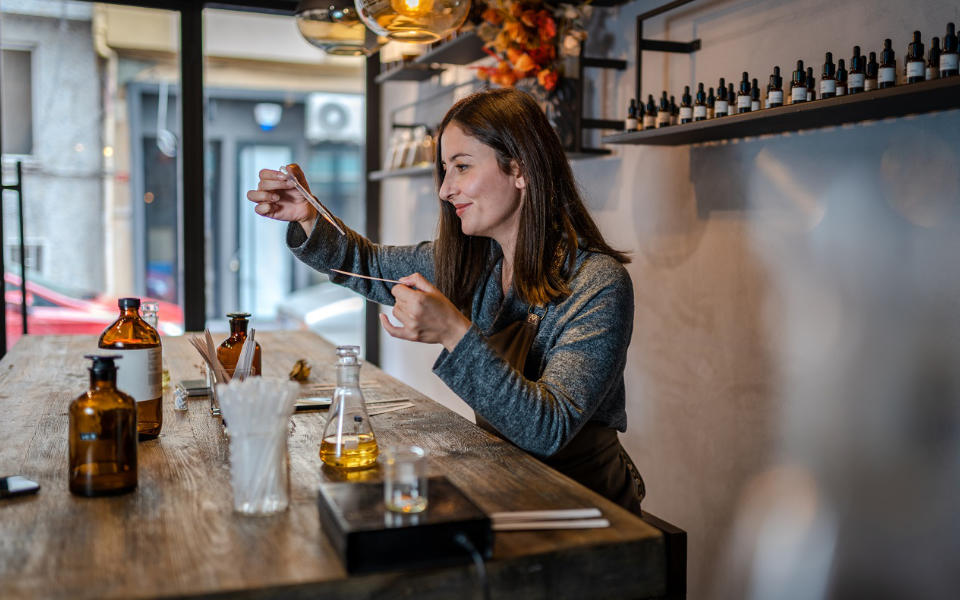
Essential oils work through topical applications, in the form of bathing, applying compresses, and massage therapy. And, of course, inhalation, which is achieved through a variety of techniques.
Because scent is the main attraction with essential oils, it makes sense that application is topical. In fact, it is strongly suggested that you do not ingest essential oils. (More on this further down)
One of the attractions of using essential oils is that they can be used safely in our homes. And we don’t need to have an ailment to benefit from their use. When we want to achieve an emotional or psychological benefit, the easiest delivery system is to diffuse essential oils.
Knowing what the benefits of the different essential oils are, is not always crucial. Often we are “led by our noses”. And with regular use, one soon develops affinities to specific scents. When you become more confident you may even start to blend your own essential oils.
The four most common ways to use essential oils are through massage therapy, inhalation/diffusion, bathing, and applying compresses.
This is the technique used by qualified aromatherapists. Massage therapy, using essential oils, has multiple benefits. The oils are absorbed through the skin, allowing the therapeutic properties to do their work.
Massage stimulates circulation, which increases oxygen to the cells through increased blood flow. Massage stimulates the lymphatic system. This, in combination with essential oils, helps the body to expel toxins. With less toxins in the body, the immune system (that produces its own antibodies) becomes stronger and more capable of reducing oxidants (the free radicals that wreak havoc on our cells). These are the physical benefits of massage. Less mentioned are the psychological benefits. The power of touch has the ability to unlock deep-seated emotions that are often the root cause of physical ailments. These also need to be eliminated as they are toxic to the system.
Aside from getting professional massages with essential oils, you can self-massage. Add techniques like dry skin brushing. Dry skin brushing stimulates the lymphatic system. Do this before your bath or shower and afterward, you can apply your essential oil of choice (which should be blended with a base oil).
Do not get massaged if you have the following:
Avoid using these oils when getting a massage during pregnancy:
Using essential oils to scent a room is the easiest and most refreshing way to benefit from their profound effects. If you don’t have a burner or diffuser you can use cotton wool or a piece of cloth. See the section below on how to use diffusers.
a) Steam inhalation: Add 4 – 6 drops of essential oil to a bowl of hot water. Place your face as close to the steam as possible. Cover your head with a towel, to keep the steam from evaporating too fast. Inhale through the nose and exhale through the mouth for 1 – 5 minutes, or until there is no longer steam.
Note: Don’t try this method on children younger than 7. For children below the age of 12, halve the number of drops to 2 – 3.
b) Room sprays: To replace aerosol air “fresheners”. Add water to a spray bottle. Add 6 – 12 drops of essential oils. You can use one oil or add a combination. Once you get familiar with essential oils, you’ll instinctively know how many drops of each oil to add, to make up the 6 – 12 drops. It’s suggested to not add more than three types to one blend.
Draw a bath with hot water (not extremely hot), add 6 – 12 drops of oil. Use one oil or a blend of two or three. And give the water a swirl with your hand. Immerse yourself and close your eyes. Allow your mind to be still and focus only on the scent you are smelling.
This exercise is highly effective. It brings you down from a busy day, it calms your thoughts and soothes your stresses. By focusing entirely on the smell experience you are able to escape momentarily while at the same time connecting to yourself.
It is a lovely way to ground oneself. Initially, you may experience slight feelings of lightheadedness. If this happens, breathe in deeply through your nose and exhale slowly through your mouth, keeping your eyes closed or open.
You can also wet a facecloth with the hot bathwater, and add 3 – 4 drops of oil. Fold it into a band and place on your forehead, over your nose, or over your neck, and breathe. Effective for a phlegmy chest if you use eucalyptus or mint, with a dash of lemon and/or rosemary essential oils.
For bathing to relax and unwind: Use essential oils that calm, revitalize, rejuvenate. Avoid oils that stimulate, like rosemary. A great blend is orange, lavender, and cypress. Or just plain lavender.
Use an essential oil compress to relieve pain and swelling (anti-inflammatory). Compresses can be applied to aid with toothache, headaches, muscular injuries, joint pain, and any other type of inflammation or swelling. Use cold compresses to subdue hot pain, like a fresh sprain or a headache. And hot compresses when the pain needs to “be pulled”, in the case of a toothache, boils, old injuries.
To make a compress: Fill a small bowl with water, add 6 – 12 drops of oil. Soak a cloth or bandage in the water, gently squeeze out excess liquid, place over the appropriate area, and secure with clingfilm.
You can also use infused oil, like a comfrey maceration. Using coconut oil to macerate herbs like comfrey is effective, as the coconut oil contains some healing properties too. You can use infused oils to massage inflamed areas, like sprains or bites.
For sprains and muscular injuries: Use infused oils like rosemary infused with almond/grapeseed oil, or comfrey macerated with coconut oil.
For bites: Use infused oils, or oil blends, containing lavender or tea tree oil.
Essential oils with anti-inflammatory properties include:
Mouthwashes/Gargles – The best oil to use as a mouthwash is tea tree oil. Fill 1/2 a glass (125ml) with water, preferably room temperature. Add 4 drops of tea tree oil. Take a medium sip. Gargle and swirl around, spit out. DO NOT swallow.
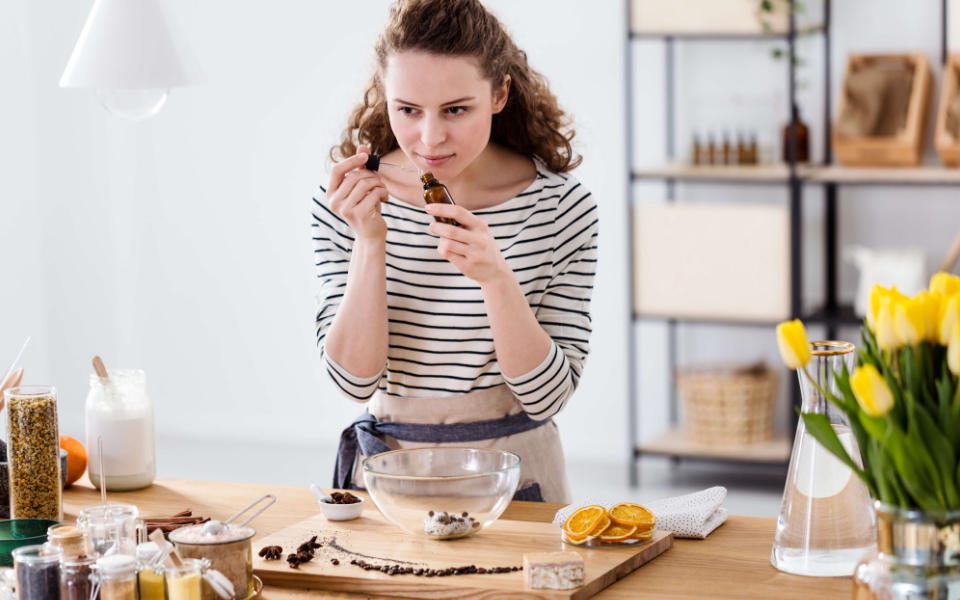
According to Christine Wildwood, qualified aromatherapist and author, “Essential oils promote natural healing by stimulating and reinforcing the body’s own mechanisms.”
Essential oils, being the essence of the plant they are extracted from, exhibit “characteristics” or attributes. When we get to know these types it helps us to connect the ailment to the type of oil we should use. We learn this by using the oils regularly. But to save you time here is a list of the most effective and safe essential oils to use from home.
Botanical Name: Lavandula angustifolia. This is English Lavender and is preferred for medicinal and culinary purposes. French Lavender is Lavandula dentata. It is widely used in perfumery and the cosmetic industry.
Extracted by steam distillation of the entire plant, excluding roots.
Use in massages, burners, baths, diffusers, by inhalation methods, compresses, mouthwash,
Blends well with most essential oils. But goes very well with eucalyptus, lemon, tea tree, rosemary, peppermint, bergamot, cedarwood, cumin, petitgrain, neroli, and all other citrus oils.
Properties: Antiseptic, disinfectant, sedative, relaxing, uplifting, balancing, calming, antispasmodic, insect repellant,
Cosmetic Uses: Skin care – lavender essential oil can be added to aqueous cream and applied to dry skin. The benefits of lavender’s calming properties will come through. Lavender can be applied directly onto the skin for all minor wounds, and cuts. But it is always safer to mix with a carrier oil.
Safety: Lavender essential oil is by far the safest oil to use. It is gentle yet extremely powerful in treating infected wounds. It can be dabbed directly onto the skin to soothe an insect bite, cut, or abrasion. And promotes healing, reducing scarring.
Botanical name: Citrus limon
Extracted by expression from rinds.
Use with compresses, baths, massages, inhalation, diffusers
Blends well with other citrus oils, lavender, peppermint, eucalyptus, ylang-ylang, neroli, black pepper, jasmine, eucalyptus, citronella, ginger, and geranium.
Properties: Sparkling, refreshing, antiseptic, invigorating, detoxifying, nourishing, cleansing, exfoliating, antibacterial, anxiety-reducing, lifts depression, anti-inflammatory, a common component in cold and flu remedies.
Cosmetic Uses: Skin care. Lemon essential oil treats oily skin and acne. The antibacterial and antiseptic properties disinfect acne-induced wounds. Mixed with lavender in a carrier oil it can also reduce scarring.
Safety: Can irritate sensitive skin. Sensitive to sunlight (phototoxic). So it is best not to use topically before sun exposure.
Botanical Name: Rosmarinus officinalis
Extracted by distillation using leaves and flowering tops.
Use in bathing, massage, compresses, diffusers, inhalation, mouthwash.
Blends well with black pepper, tea tree, lavender, peppermint, lemongrass, orange, petitgrain, and pine.
Properties: Stimulating, invigorating, acts as a liver tonic,
Cosmetic Uses: Hair care, skin care
Safety: DO NOT use it on people with epilepsy or people that have high blood pressure. Not safe during pregnancy. Make sure it is used in the correct diluted strength.
Botanical Name: Origanum marjoran
Extracted by steam distillation of leaves and flowering tops.
Use in massage, bathing, compresses, inhalation, diffusers.
Blends well with lavender, bergamot, rosemary, eucalyptus, tea tree, peppermint, cedarwood, thyme, and geranium.
Properties: Sedative, carminative, eases flatulence/indigestion, antispasmodic, analgesic, warming, penetrating. Often used for digestive troubles and in gut health.
Cosmetic Uses: Mainly used for medicinal and culinary purposes.
Safety: Always use the correct dilution as the sedative effects of marjoram essential oil is quite effective. Definitely don’t use it when pregnant as marjoram is an emmenagogue. An emmenagogue is a plant that brings on menses.
Botanical Name: Mentha piperita
Extracted by steam distillation and the entire plant, bar the roots, are used.
Use in massage, diffusers, inhalation, compresses, baths, and mouthwashes
Blends well with eucalyptus, lavender, lemon, marjoram, jasmine, pine, and rosemary
Properties: Antispasmodic, tonic for circulatory system, expectorant and antiseptic, reviving, digestive.
Cosmetic Uses: Skin care
Safety: DO NOT use on babies and small children (under 7). Don’t take late at night as the reviving properties will keep you up.
Frankincense is a very regal essential oil. It stirs up connotations of luxury, religion, ceremony, and indulgence. Frankincense is used in the preparation of incense. Frankincense oil (and incense) used during meditation to slow breathing and sharpen focus.
Botanical Name: Boswellia carteri
Extracted by steam distillation. The resin is used.
Use in vaporisers, burners, and steam inhalation.
Blends well with equally luxuriant oils like sandalwood, neroli, myrrh, and rose. It is masculine. Perhaps this is because it is extracted from the resin of the tree, as opposed to the flowers.
Properties: It is grounding, stimulating, soothing, uplifting, woody, and warm. It is anti-inflammatory.
Used to treat bronchitis, laryngitis, coughs. It soothes inflamed mucus membranes.
Cosmetic uses: Skin care
Safety: Frankincense oil is safe to use. Avoid during early pregnancy.
Botanical Name: Melaleuca alternifolia
Extracted by steam distillation, using the leaves.
Use in compresses, massage, inhalation, diffusers, mouthwashes, bathing.
Blends well with black pepper, cumin, eucalyptus, lavender, lemon, marjoram, thyme, rosemary, nutmeg, and pine.
Properties: Antiviral, antibacterial, antifungal, antiseptic, immunostimulant, and antimicrobial. Antimicrobial properties are sanitising.
Cosmetic Uses: Skin care, hair care.
Safety: Tea tree oil can be applied directly onto the skin. It is nontoxic and nonirritant. Very rarely, the odd person may experience sensitivity.
Botanical Name: Santalum album
Extracted by steam distillation. The heartwood of the tree is used, not the bark. It is dried and powdered and only then is the oil extracted using steam.
Use in massages, inhalation, compresses, diffusers, bathing
Blends well with bergamot, cedarwood, jasmine, lavender, ylang-ylang, rose, vetiver, patchouli, rosewood.
Properties: Cooling, quieting, calming, soothing, relaxing. Emollient, anti-inflammatory, astringent, aphrodisiac.
Cosmetic Uses: Fragrance fixative in cosmetics and perfumes. Skin care, used in aftershaves, colognes, and when mixed with a carrier oil, or cream, can be applied to dry cracked skin.
Safety: Completely safe, nontoxic, nonirritant, non-sensitising
Botanical Name: Eucalyptus globulus (blue gum)
Extracted by steam distillation of the leaves.
Use in diffusers, massage, inhalation, bathing, and compresses.
Blends well with lavender, marjoram, rosemary, lemon, peppermint, tea tree, thyme, cajeput, cedarwood, star anise.
Properties: Antiseptic, antibacterial, decongestant, anaesthetic, good for all respiratory conditions, antiparasitic, insect repellant.
Cosmetic Uses: Skin care
Safety: Eucalyptus essential oil can be an irritant to skin. Dilute well and use sparingly. Eucalyptus essential oil is toxic when ingested orally. Not safe to use during pregnancy.
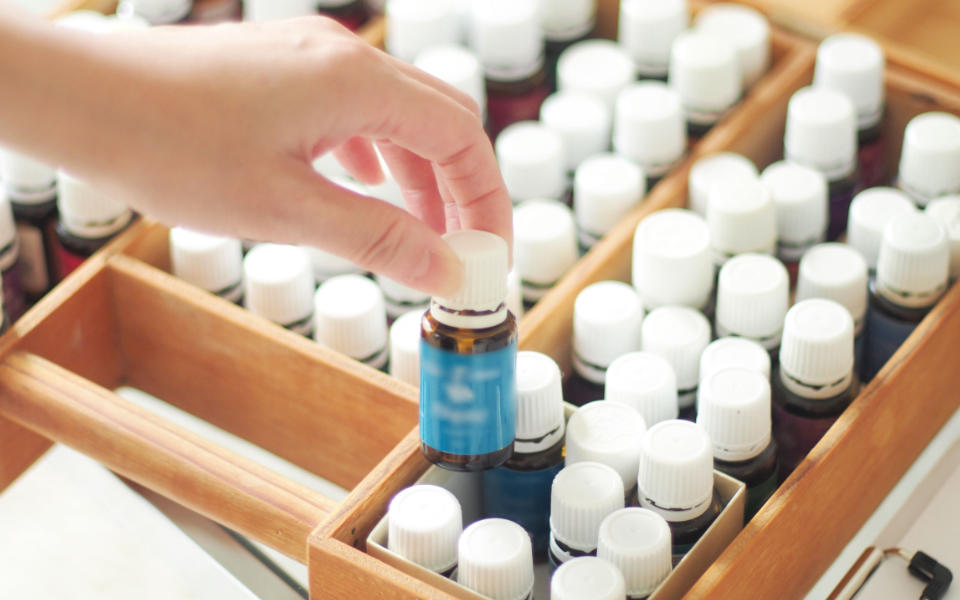
The 9 essential oils listed above are very versatile. They blend well with a lot of other oils and each of these oils brings something unique to the mix. Combined they make up the perfect, Basic Essential Oils First Aid Kit.
For the most part, these 9 essential oils are the safest to use around the house. Children and pets will not be affected by the scent of these oils being diffused. It may be different if using them during a massage.
These 9 essential oils are all you may need to treat the most common ailments and injuries that often happen in the home but aren’t serious enough to have to see the doctor or visit the emergency room.
Of course, once you have this kit assembled you’ll soon discover which other oils you need to add to your EO Kit. Especially when you become adept at blending your own oils. Once you start creating blends you won’t be able to resist adding the allure of the Ylang-Ylang, or the reassuring Neroli. The spiciness of Black Pepper essential oil blended with lavender and lemon will shock your “nose buds”! But in the most pleasant way, you can imagine.
Choose a selection of base oils, also known as carrier oils, to keep on hand. Certain oils suit specific treatments and applications. So take your time deciding what you want to use your essential oils for. Then you will know which carrier oils to add.
Examples of carrier oils are:
For Hair: Argan oil, coconut oil, olive oil (although it can have a distinct smell that is overpowering), and Amla oil.
For Skin: Add appropriate oil to beeswax, jojoba oil, coconut oil, shea butter, aqueous cream. Very light oils are ideal for face treatments. Use carrier oils like apricot kernel, almond oil, grapeseed oil, and wheatgerm oil. A thick oil like wheatgerm must be diluted with another carrier oil.
For Massage: The favourite carrier oils are almond, grapeseed, and wheatgerm blends.
You can experiment with blending your own oils. Use the guide that came with each description of our 9 essential oils to see what blends well. Try your own recipes.
The quantity of carrier oil to essence will depend on what method you will be using. If you are burning or diffusing, the blend will be a small quantity, opposed to if you are mixing a blend for massage.
It is always better to make a fresh blend, to reduce evaporation and efficacy.
Before mixing a blend ask yourself what are you trying to achieve? Do you want to relax or do you need to be revitalised? Is it a respiratory condition or a skin complaint? Will it be inhaled or used as a compress?
A base oil, or carrier oil, is the oil used to transport the essential oil via massage or inhalation, etc. Because essential oils are quite strong they need to be diluted with a carrier oil.
A base oil is usually a seed or nut derived oil. These are the carrier oils most commonly used:
Store in a cool dark space. Only use glass vessels and make sure the glass is tinted either blue, green or brown.
Keep base oils for one year and then replace them.
Anything that assists in dispersing the scent of essential oils, whether through the air, water, or heat, can be called a diffuser.
a) DIY diffusers: Place a few drops of lavender essential oil on a ball of cotton wool and place in a drawer or cupboard. Alternatively, place a few drops of oil on a damp cloth and place it over the radiator. As it heats up the fragrance will spread throughout the room.
b) Himalayan Salt Diffuser: Instead of placing water on your burner, replace it with Himalayan salt, which comes with its own set of air filtering benefits. Light the tea candle and add 4 – 6 drops of essential oil directly onto the salt. It seems to be more effective than using water.
c) Ceramic Burners: The oil is placed onto the ceramic ring and put over a light bulb. The heat causes oil to evaporate, releasing the scent. Some ceramic burners will have a top section where you can place salt or water. Add the drops to this. Light the tea candle and put it in the appropriate holding space.
Ceramic burners are affordable and ideal for small, enclosed areas. They are the least effective diffusers for therapeutic purposes but are great for everyday use, to scent rooms.
d) Nebulizers: Nebulizers are often only used when there is a chronic respiratory condition where the patient requires assistance breathing, but doesn’t yet need actual oxygen. They can be noisy, expensive, and difficult to clean. But when used properly are very effective.
When using nebulizers on babies and children under 7, DO NOT add essential oils.
e) Ultrasonic diffusers: These diffusers can also act as humidifiers. They are less costly than nebulizers and easier to maintain. They can be set to timers, releasing a spray at intervals.
f) Reed diffusers: With rattan reed diffusers you usually buy the reeds and the vessel as a kit. You add your oils to a carrier oil and place the reeds directly into the oil. The opening of the vessel is usually narrow.
Reed diffusers are not suited to therapeutic aromatherapy but are wonderful for everyday use. The subtle scent which constantly lingers enhances one’s mood and you can place reed diffusers throughout your house.
Try a lemon or lemon-scented eucalyptus in the kitchen. Place a lavender reed diffuser in the bathroom. And let each member of the household choose their own favourite scent, or blend, for their rooms.
When used correctly, essential oils are safe. That said, some are safer than others. Because these oils hold the “essence” of a plant’s power in concentrated form they must be used with far more caution than one would exercise if only fresh herbs or flowers were being used.
For example, jasmine flowers from the Jasminum family are edible and safe to eat anytime. (Unless they have been sprayed with pesticides.) But the Jasmine essential oil is a powerful uterine stimulant and so using it during pregnancy is not safe.
Jasmine tea is an excellent sedative and muscle relaxant. And using Jasmine essential oil during massage not only eases stiff muscles but also acts as an antidepressant and relieves anxiety-related sexual problems. But taking Jasmine oil orally/internally is not advised.
The short, and safe, answer is, “No”.
Most oils are best avoided during pregnancy, for various reasons. Often it is because the oils in question are intra-uterine stimulants or abortifacients.
Because essential oils are primarily used to help the body perform more efficiently they are often used to treat menstrual disorders, one of which is the bringing on of delayed menses.
It is obvious then why using essential oils is best avoided if you are, or suspect you are, pregnant. But in some cases oils may be used to bring on labour naturally. And the very same oils that were deemed unsafe, become useful.
Using oils during pregnancy may mask smells that may cause morning sickness. This may unwittingly lead women in early pregnancy to miss vital warning signs the body sends out
It is advised not to use essential oils on babies. And also avoid using them on children younger than 7. For older children, the dilution can be diluted by double.
The safest essential oils for babies and children are lavender and chamomile.
Use diffusers and steam inhalations without oils. Do not steam to treat asthma.
Dogs and cats have very powerful and sensitive olfactory systems. It is advisable to only use essential oils to treat animals if your vet has been consulted. Oils like lavender and tea tree oil are the safest. And base oils like coconut can be used topically on pets.
Essential oils are often too concentrated to take orally. Sometimes the extraction methods leave residual traces of solvents behind which could be toxic if taken internally. You can, however, take herbal tinctures orally. They have been made using different techniques, and to treat specific ailments.
Essential oils are so powerful that oral ingestion, taken without proper dosage or guidance, can cause damage to internal organs, like the liver and kidneys. There was a time, in the past, when it was advised to take them internally. This is no longer an acceptable practice. And today’s aromatherapists will advise against it.
When Sunbathing: Bergamot, lemon, mandarin, orange, grapefruit, lime, verbena – can cause pigmentation.
Never use: Sassafras – same family as the bay tree. Can cause cancer.
As a Layman: Penny royal, thuja, sage (not the same as clary-sage), wintergreen, thyme – can cause kidney and liver toxicity.
On the Skin: Cinnamon bark, cinnamon leaf, cloves
In Pregnancy: All oils, with the exception of lavender. Ginger essential oil helps for nausea, but rather drink tea. You don’t want to stop vomiting during morning sickness. Throwing up during morning sickness is the body’s way of protecting the fetus (baby) and mother.
Disclaimer: And why Essential Oils are not considered medicine by Science.
The above information must not take the place of a professional consultation with your health practitioner of choice. Always remember aromatherapy is a complementary therapy. It should be used in conjunction with, and not in place of, medical treatment.
Scientific studies on essential oils are difficult to carry out. This is due to the fact that so many variables can influence results. Factors like soil condition, climate, habitat, and general health of the plants all need to be uniform and constant in order for science to determine efficacy.
Science does not factor in criteria that cannot be measured. So it is difficult to prove scientifically what natural health practitioners know and trust to be effective remedies. Again, it can’t be stipulated enough, the quality of the oils will determine the measure of the results. So how an oil is extracted, where it was grown, whether it’s organic, and if so how good was the nutrient profile of the soil it was grown in, all count.
It is these unknowns that prohibit science from embracing natural medicines, as they cannot be regulated like synthetic products.
Always purchase from trusted brands.